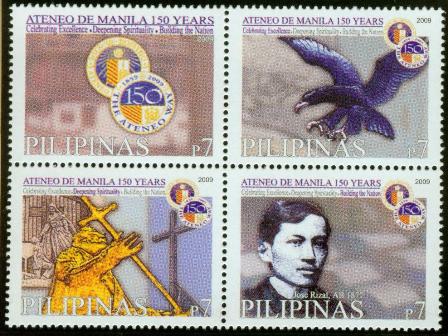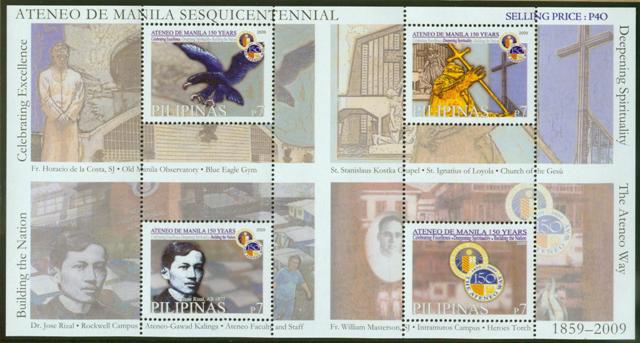2009, June 14. Ateneo de Manila, 150th Anniversary
Litho Offset. Amstar Company, Inc. Perf. 14.
Se-tenant Blocks of 4 (10 Blocks per sheet), Sheets of 40 (4 x10)

Se-tenant Blocks of Four (34,000)
7p Sesquicentennial logo
7p Blue Eagle
7p St. Ignatius de Loyola
7p Dr. Jose Rizal
Souvenir Sheets of Four (7,000) priced at P40 each
First Day Covers: Manila
Official FDC Envelopes: 4 different designs, 12,200 issued at P36 each
Official Souvenir Folders: 3,200 issued at P200 each
Note: Of the 12,200 FDC envelopes, 8,000 were sold to Ateneo with single stamps each (total of 2,000 sets of FDCs). The remaining 4,200 FDC envelopes were affixed with a SB/4 of the stamps: 3,200 were put on Souvenir Folders, of which 3,000 were bought by Ateneo. The Souvenir Folders contain a mint souvenir sheet and an FDC.
Ateneo de Manila Sesquicentennial Anniversary
Sesquicentennial means a 150th anniversary or its celebration. The term comes from a combination of the Latin-Greek derivative “sésqui,” meaning, one-and-a half, and the American-Latin derivative “centennial,” which pertains to 100 years.
The three-year run-up to the Ateneo de Manila’s Sesquicentennial, anchored on the overarching theme “150 Years The Ateneo Way,” kicked off on 5 August 2007 at the Church of the Gesù on the Loyola Heights campus. The three-year celebration culminates on 10 December 2009, exactly 150 years since the Jesuits returned to the Philippines after almost a hundred years away from the country.
Almost 150 years ago, the Jesuits arrived in Manila with the intention of starting missions in Mindanao. But because they were requested by the people of Manila, on 10 December 1859, they began a school called the Escuela Municipal de Manila. Located right across the San Ignacio Church in Intramuros, it was the very first Ateneo campus.
The following themes for the three-year Sesquicentennial Festivities evoke in all Ateneans fond memories and as well as new meanings in their connection with the school they have chosen and which has, in a big way, also chosen them.
CELEBRATING EXCELLENCE
Commemorating a passion for excellence and challenging students to develop their gifts and to be the best that they can be.
DEEPENING SPIRITUALITY
Nurturing Ignatian spirituality: Discovering and responding to Christ’s call and finding God in all things.
BUILDING THE NATION
To be men and women and professionals for others in the building up of our nation.
History
The Ateneo de Manila University began in 1859 when Spanish Jesuits established the Escuela Municipal de Manila, a public primary school established in Intramuros for the city of Manila. However, the educational tradition of the Ateneo embraces the much older history of the Jesuits as a teaching order in the Philippines.
The first Spanish Jesuits arrived in the country in 1581. While primarily missionaries, they were also custodians of the ratio studiorum, the system of Jesuit education formulated about 1559. In 1590, they founded one of the first colleges in the Philippines, the Colegio de Manila (also known as the Colegio Seminario de San Ignacio) under the leadership of Antonio Sedeño, S.J. The school formally opened in 1595.
In 1621, Pope Gregory XV, through the archbishop of Manila, authorized the San Ignacio to confer degrees in theology and the arts. Two years later, King Philip IV of Spain confirmed this authorization, making the school a royal and a pontifical university, the very first university in the Philippines and in Asia.
However, by the mid-18th century, Catholic colonial powers, notably France, Portugal, and Spain, had grown hostile to the Society of Jesus. The colonial powers eventually expelled the Society, often quite brutally, from their realms.
The Jesuits had to relinquish the San Ignacio to Spanish civil authorities in 1768, upon their violent expulsion from all Spanish territories. Finally, under pressure from Catholic royalty, Pope Clement XIV formally declared the dissolution of the Society of Jesus in 1773.
Pope Pius VII reinstated the Society in 1814, after almost seven decades of persecution and over four decades of formal suppression. However, the Jesuits would not return to the Philippines until 1859, almost a century after their expulsion.
Authorized by a royal decree of 1852, ten Spanish Jesuits arrived in Manila on April 14, 1859. This Jesuit mission was sent mainly for missionary work in Mindanao and Jolo. However, despite almost a century away from the Philippines, the Jesuits’ reputation as educators remained entrenched in the minds of Manila’s leaders. On August 5, the ayuntamiento or city council requested the Governor-General for a Jesuit school financed by public money.
On October 1, 1859, the Governor-General authorized the Jesuits to take over the Escuela Municipal, then a small private school maintained for 30 children of Spanish residents. Partly subsidized by the ayuntamiento, it was the only primary school in Manila at the time. Under the Jesuits, the Escuela eventually became the Ateneo Municipal de Manila in 1865 when it was elevated to an institution of secondary education. The Ateneo Municipal offered the bachillerato as well as technical courses leading to certificates in agriculture, surveying, and business.
When American colonial rule came in 1902, the Ateneo Municipal lost its government subsidy. In 1908, the colonial government recognized it as a college licensed to offer the bachelor’s degree and certificates in various disciplines, including electrical engineering. In 1909, years after the Ateneo became a private institution, the Jesuits finally removed the word “Municipal” from the Ateneo’s official name, and it has since been known as the Ateneo de Manila.
American Jesuits took over administration in 1921. In 1932, under Fr. Richard O’Brien, third American rector, the Ateneo transferred to Padre Faura after a fire destroyed the Intramuros campus.
Devastation hit the Ateneo campus once again during World War II. Only one structure remained standing – the statue of St. Joseph and the Child Jesus which now stands in front of the Jesuit Residence in the Loyola Heights campus. Ironwork and statuary salvaged from the Ateneo ruins have since been incorporated into various existing Ateneo buildings. Some examples are the Ateneo monograms on the gates of the Loyola Heights campus, the iron grillwork on the ground floor of Xavier Hall, and the statue of the Immaculate Conception displayed at the University archives.
But even if the Ateneo campus had been destroyed, the university survived. Following the American liberation, the Ateneo de Manila reopened temporarily in Plaza Guipit in Sampaloc. The Padre Faura campus reopened in 1946 with Quonset huts serving as buildings among the campus ruins.
In 1952, the university, led by Fr. William Masterson, S.J. moved most of its units to its present Loyola Heights campus. Controversy surrounded the decision. An Ateneo Jesuit supposedly said that only the ‘children of Tarzan’ would study in the new campus. But over the years, the Ateneo in Loyola Heights has become the center of a dynamic community. The Padre Faura campus continued to house the professional schools until 1976.
The first Filipino rector, Fr. Francisco Araneta, S.J. was appointed in 1958. And in 1959, its centennial year, the Ateneo became a university.
The Padre Faura campus was closed in 1976. A year after, the University opened a new campus for its professional schools in Salcedo Village, in the bustling business district of Makati. In October 1998, the University completed construction of a bigger site of the Ateneo Professional Schools at Rockwell, also in Makati.http://ateneo150.multiply.com/
-
Schools & Universities
-
Famous Filipinos
-
Birds
-
Famous People
-
Religious
